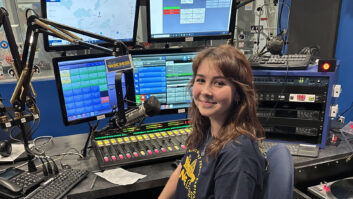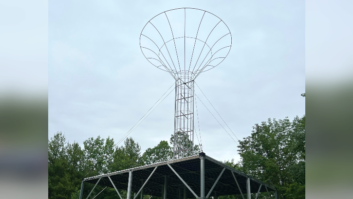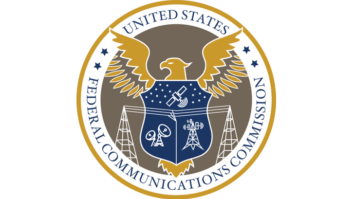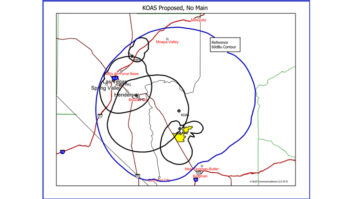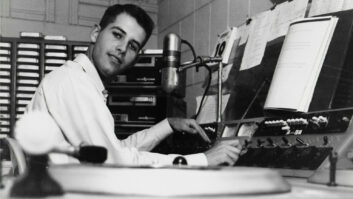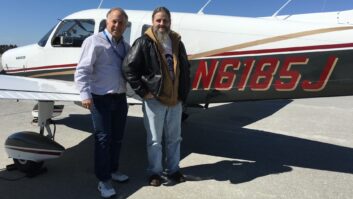The Western Electric 353E-1 transmitter seen in this photo went on the air in January of 1937 in Allentown, Pa. It served as the transmitter for not one, but both of the city’s two radio stations: WCBA and WSAN.
And therein lies an interesting story.
The two Allentown stations went on the air under separate ownership with just 5 and 10 watts, respectively, in 1923. By 1927, the Federal Radio Commission allowed both stations to increase their power to 250 watts, but they were told to share their broadcast time on the same frequency, 1440 kHz (later 1470). By then, WCBA was being operated by the Allentown Call newspaper, and WSAN by the Rev. B. Bryan Musselman.
After several years of competing operation, they made an agreement in 1934 for WCBA to assume operation of WSAN; Musselman became the manager of both stations. Even though one staff programmed the stations from combined studios, the stations continued to be owned by separate companies and operated with separate transmitters.
The transmitter of WSAN in Allentown, Pa., is shown in 1937.
Click To Enlarge
SHARE AND SHARE ALIKE

In 1936, the FCC approved the construction of a new transmitter site to be shared by both stations. The new factory-built transmitter, seen in the photo, replaced the stations’ previous home-brew equipment. The left cabinet held a complete 100-watt modulated, and the right cabinet was a 1,000-watt linear power amplifier. It fed a new 190-foot self-supporting tower that was constructed on the north edge of town.
At this point, the two stations were operating essentially as one; the same staff broadcast over the same transmitter from the same studios — only the call letters were changed, depending on the time of day.
In 1937, the two stations finally asked the FCC to approve a merger, with the Allentown Call owning 65 percent and Musselman 35 percent. They proposed that WSAN would become a full-time station; WCBA would be deleted. But the request came at an unfortunate time — Congress, led by Sen. Burton Wheeler (D-Mont.), had just raised the question with the FCC of whether a public opinion and advertising monopoly existed in the 240 cases of newspaper-owned radio stations in the country.
When the Allentown application arrived at the commission, they realized that its approval would result in one company controlling both the town’s only newspaper as well as its only radio station.
And so, the so-called “Allentown Case” was created, with a public hearing to be held in Allentown. However, FCC Commissioner Craven noted in his minority opinion that the commission needed to decide on the entire issue, rather than making a test case of one small-town station. The other commissioners ultimately agreed with him and canceled the hearing, but they put the transfer decision on hold until the larger issue could be studied.
A battle ensued over the issue of newspaper ownership, pitting the FCC against some of the biggest corporations in the country, and the WSAN-WCBA stations were caught in the middle. A number of “newspaper divorcement hearings” were held between 1941 and 1944 but no headway was made on the issue. Meanwhile, the Allentown stations continued to broadcast using the charade of dual call signs.
DUOPOLY ENFORCEMENT
In the end, it was another FCC decree that forced a decision in the Allentown case: the 1944 duopoly rule, which prevented the ownership of more than one station in a market by a single entity.
The owners of the Allentown Call finally threw in the towel and agreed to sell their interest in WCBA to local investors and exit the radio business. The FCC quickly approved the sale and the merger of the two stations, and WCBA officially ceased to exist.
Two generations of the Musselman family continued to operate WSAN until selling out in 1985. The station still exists, part of an iHeartRadio cluster.
After many call sign changes, the company reacquired the original WSAN call sign in 2007. It broadcasts today as a Fox Sports station at 5 kW using a three-tower array built in 1947 that incorporated the original 1937 tower. The city has grown up around the towers, and they now sit in the parking lot of a large shopping center.
Over the years, the FCC has gone back and forth on the issue of radio/newspaper cross-ownership. Since 1975, the commission’s rules have prohibited the common ownership of a daily newspaper and a broadcast station in the same community.
John Schneider is a lifelong radio history researcher and a longtime Radio World contributor. Write the author at[email protected].
